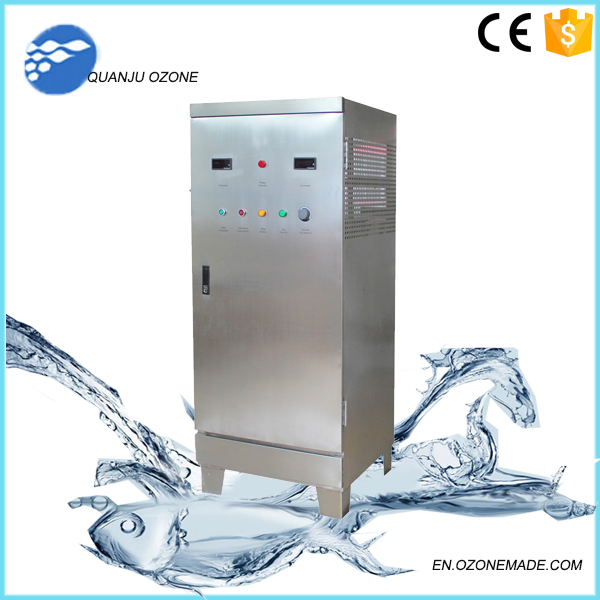ozone for fish farming,aquaculture
2017-12-28

WHY USE OZONE IN AQUACULTURE?
Removal of fine and colloidal solids
Removal of dissolved organic compounds
Removal of Nitrite
Disinfection
OZONE CAN BE USED IN WATER TREATMENT FOR THE FOLLOWING PURPOSES:
Removal of fine and colloidal solids
Fine and colloidal solids consist of particles 1-30 microns (m m) and 0.001-1 m m respectively. The small size of the particles enables the solids to remain in suspension and avoid most mechanical methods of separation. The accumulation of fine and colloidal solids can impair biofilter nitrification efficiencies and stress fish stocks.
Ozone removes fine and colloidal solids by causing clumping of the solids (microflocculation), which facilitates removal by foam-fractionation, filtration and sedimentation.
Removal of dissolved organic compounds
Dissolved organic compounds (DOC’s) or refractory organics, give the water a characteristic tea-coloured stain. DOC’s are non-biodegradable and accumulate according to feed input, water exchange rate and the rate of solids removal. High levels of DOC’s can stress fish and reduce nitrification efficiencies of the biofilter.
Removal of Nitrite
Nitrite can accumulate as production intensifies and organic loadings on the biofilter increase. Bacteria that process ammonia into nitrite (Nitrosomonas spp) operates more efficiently under high organic loadings than bacteria that process nitrite to nitrate (Nitrobacter) and levels of nitrite rise accordingly.
High levels of nitrite can be toxic to fish. Data available for silver perch, Bidyanus bidyanus indicates levels of nitrite as low as 2.8 parts per million (ppm) can reduce growth of fingerlings by 5%..
Disinfection
The high stocking densities, associated fish stress and increased nutrient loads found in RAS create an ideal environment for fish pathogens. An important step in reducing the risk of disease outbreaks in RAS is the use of standard quarantine procedures for any fish introduced. Facilities using surface waters, including RAS and flow-through hatchery systems, are also interested in reducing the pathogen load introduced via the source water. The disinfection of effluent waters before introduction to the environment is also crucial to prevent the translocation of exotic diseases.
Ozone can effectively inactivate a range of bacterial, viral, fungal and protozoan fish pathogens. The effectiveness of ozone treatment depends on ozone concentration, length of ozone exposure (contact time), pathogen loads and levels of organic matter. If high levels of organic matter are present, the demand created by oxidising the organic matter can make it difficult to maintain enough residual ozone for effective disinfection.
Treatment Regimes
Ozone can be applied continuously, as a series of treatments per day or as a single batch treatment per day. Application in most situations can be linked to the feeding strategy employed in the culture system. Three to four hours after feeding fish, the concentrations of ammonia, dissolved organics and other wastes products reach a maximum. If fish are fed several times during the day, a series of ozone treatments can be introduced after each feed to target the associated rise in waste levels. If feed is introduced 24 hours per day, water quality degrades continuously and so ozone application should be continuous. A single batch ozone treatment can be used to target rises in waste levels in the system associated with a moderate feed event or to treat batches of exchange or inlet water from the supply source.
Continuous ozonation is beneficial when compared to batch and serial treatments because water quality remains relatively stable. However, the lower costs of serial and batch ozonation make these treatments regimes viable management options. The required amount of ozone for treatment in an RAS (Recirculating Aquaculture Systems) is usually calculated according to the daily feed rate. Rates of 10-15 g of ozone per kilogram of feed are generally recommended to reduce accumulated organics. Any background organic loadings of the source water used for the RAS should also be taken into account.
If disinfection is the primary goal of ozonation, the amount of ozone necessary is largely dependent on the background organic loading of the water to be treated. In pure water, residual concentrations of 0.01-0.1 ppm ozone for periods as short as 15 seconds can be effective in reducing bacterial loads. However, in water with organic loadings the residual ozone concentration and/or contact time of ozone must be increased to produce significant disinfection. Natural waters (seawater, brackish and freshwaters) generally require residual concentrations of between 0.1-0.2 ppm ozone and contact times of 1-5 minutes for disinfection. Aquaculture effluent generally requires between 0.2-0.4 ppm residual ozone for 1-5 minutes for significant disinfection to occur after oxidation of organics.
The optimum rate of ozone for disinfection is highly variable and represents the sum of ozone demands from dissolved organics, colloidal solids, nitrate and disinfection. In many situations in RAS, the cost of production of sufficient residual ozone for complete disinfection after all other ozone demands are met is prohibitive. However, some reduction in pathogen loads can be achieved using moderate levels of ozone, and water quality improvements are considerable. Disinfection of exchange and effluent water is more cost effective than treating the entire system due to the relatively small volumes treated. Disinfection of source water with ozone, in combination with quarantine procedures for incoming stock, reduces the risk of disease outbreak within the system
Quick Links


